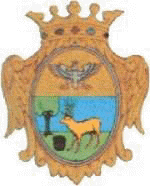 Mortara is located in the north-west of Italy.It's
Mortara is located in the north-west of Italy.It's
from Milan.It's a little town in the province of Pavia, with
a population of 15.000
A HISTORICAL PROFILE
The earliest settlements appeared in the territori where Mortara now lies around 1600 B.C.The name of the town was originally“Mortier”, bestowed upon the village by the Gauls or Celts who later conquered the Liguri tribe, who had been the first settlers. The Romans later ruled the area and changed the name of the town to the Latin “Mortaria”. After the fall of the Roman Empire,the area fell into the hands of the
story concerning to same battle tells how two Frankish knights named Amicus and Amelius were killed and buried in two separate churches. The next day they were both found in the same sepulcher, unitedin death as they had been in life. St. Albinus’s Abbey, where they were buried, became a place of pilgrimage, beind located along the
rule in the 16th century, and was annexed to the
A TOUR OF THE TOWN
ST. LAWRENCE’S BASILICA – This Gothic basilica was built between 1375 and 1380 and remodeled in 1840 and 1916. The interior of the basilica is rich in important works of art, such as the sixsteen-century painting of “The Madonna with St. Rocco and St. Sebastian” by Gaudenzio Ferrari, “Our Lady of the Rosary” by Bernardino Lanìno, which is signed and dated 1578, five paintings by Procaccini, and a large painting by G.B. Crespi, signed and dated 1610
This Gothic basilica was built between 1375 and 1380 and remodeled in 1840 and 1916. The interior of the basilica is rich in important works of art, such as the sixsteen-century painting of “The Madonna with St. Rocco and St. Sebastian” by Gaudenzio Ferrari, “Our Lady of the Rosary” by Bernardino Lanìno, which is signed and dated 1578, five paintings by Procaccini, and a large painting by G.B. Crespi, signed and dated 1610
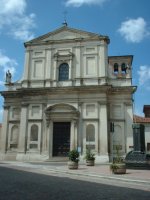 HOLY CROSS ABBEY – The abbey was founded in the year
HOLY CROSS ABBEY – The abbey was founded in the year
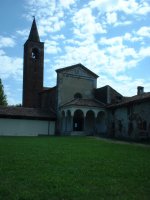 ST. ALBINUS’S ABBEY – The abbey stands on the outskirts of town along Route 494, on the spot where the bloody battle was fought in
ST. ALBINUS’S ABBEY – The abbey stands on the outskirts of town along Route 494, on the spot where the bloody battle was fought in
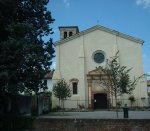 SANTA MARIA DEL CAMPO SANCTUARY – This simple but elegant church is located a little over a mile of Mortara, in a little villane. It has a single nave broken up by eight niches, four on each side. There are frescoes from different periods in the sanctuary, including the main altarpiece by Tommasino da Mortara.
SANTA MARIA DEL CAMPO SANCTUARY – This simple but elegant church is located a little over a mile of Mortara, in a little villane. It has a single nave broken up by eight niches, four on each side. There are frescoes from different periods in the sanctuary, including the main altarpiece by Tommasino da Mortara.
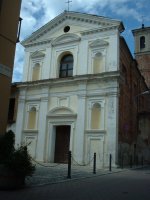 |
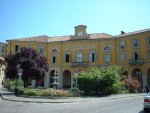 |
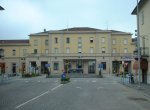 |
| T. VENERANDA cen. XVII | TOWNHALL | RAILWAY STATION |
Mortara and the entire area surrounding Lomellina offer the gourmet visitor a vast selection of dishes. The specialty which has made the town famous in other parts of
the year 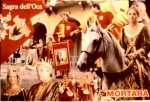
was facilitated in Mortara by the presence of a small Jewish community
in the area. In 1913, goose salame won a gold medal at the International
temperature with vegetables and other types of salame such as “salm d’la duja”which is packet in fact at cured in terracotta jars. Other delicious products are made from goose in Mortara, including “ciccioli” (fried scraps of fat), little goose hams, smoket goose breasts, and goose patè of “foie gras”. Rice is another of Mortara’s favorite dishes, and it is prepared in many different ways. From the rice fields comes and additional delicacy: frogs. They were traditionally caught by the local women and girls during the daytime in the months of April,September and October, and during the night in May and June.
THE GOOSE FESTIVAL It's also famous for "Festa dell'oca". This takes place on the last Sunday in September, every year.Here you can find many products made by local craftsmen.


